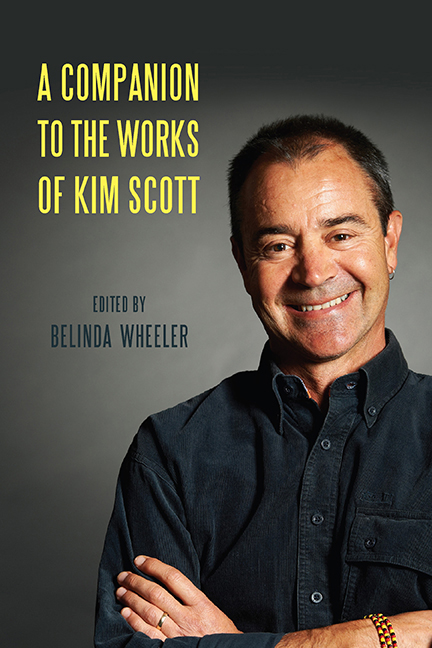Book contents
- Frontmatter
- Contents
- Foreword
- Acknowledgments
- Note on Orthography
- Chronology of Key Writings
- Introduction
- 1 Kim Scott’s Publishing History in Three Contexts: Australian Aboriginal, National, and International
- 2 Kim Scott’s True Country as Aboriginal Bildungsroman
- 3 The Land Holds All Things: Kim Scott’s Benang—A Guide to Postcolonial Spatiality
- 4 Kim Scott’s Kayang and Me: Noongar Identity and Evidence of Connection to Country
- 5 “Wreck/Con/Silly/Nation”: Mimicry, Strategic Essentialism, and the “Friendly Frontier” in Kim Scott’s That Deadman Dance
- 6 The International Reception of Kim Scott’s Works: A Case Study Featuring Benang
- 7 Traumatic Landscapes: Inscribing Spectrality and Identity in Kim Scott’s “A Refreshing Sleep,” “Capture,” and “An Intimate Act”
- 8 Spatial Poetics and the Uses of Ekphrasis in Kim Scott’s “Into the Light” and Other Stories
- 9 The Poetry of Kim Scott
- 10 The Wirlomin Project and Kim Scott: Empowering Regional Narratives in a Globalized World of Literature
- 11 Kim Scott as Boundary Rider: Exploring Possibilities and New Frontiers in Aboriginal Health
- 12 An Interview with Kim Scott
- Notes on the Contributors
- Index
6 - The International Reception of Kim Scott’s Works: A Case Study Featuring Benang
Published online by Cambridge University Press: 08 May 2021
- Frontmatter
- Contents
- Foreword
- Acknowledgments
- Note on Orthography
- Chronology of Key Writings
- Introduction
- 1 Kim Scott’s Publishing History in Three Contexts: Australian Aboriginal, National, and International
- 2 Kim Scott’s True Country as Aboriginal Bildungsroman
- 3 The Land Holds All Things: Kim Scott’s Benang—A Guide to Postcolonial Spatiality
- 4 Kim Scott’s Kayang and Me: Noongar Identity and Evidence of Connection to Country
- 5 “Wreck/Con/Silly/Nation”: Mimicry, Strategic Essentialism, and the “Friendly Frontier” in Kim Scott’s That Deadman Dance
- 6 The International Reception of Kim Scott’s Works: A Case Study Featuring Benang
- 7 Traumatic Landscapes: Inscribing Spectrality and Identity in Kim Scott’s “A Refreshing Sleep,” “Capture,” and “An Intimate Act”
- 8 Spatial Poetics and the Uses of Ekphrasis in Kim Scott’s “Into the Light” and Other Stories
- 9 The Poetry of Kim Scott
- 10 The Wirlomin Project and Kim Scott: Empowering Regional Narratives in a Globalized World of Literature
- 11 Kim Scott as Boundary Rider: Exploring Possibilities and New Frontiers in Aboriginal Health
- 12 An Interview with Kim Scott
- Notes on the Contributors
- Index
Summary
THIS CHAPTER DRAWS ON recent trends in Australian literary criticism to scan new horizons for readings of Kim Scott's novel Benang (1999) and to consider what these readings indicate about the networks that shape various scenes of reading and interpretive communities for the production and reception of Australian Indigenous writing. Scott is devoted to the language and country of the Noongar people and this inspires the generic and linguistic innovation of Benang and That Deadman Dance (2010), as well as the innovative collaborative life writing of Kayang and Me (2005). Benang and its author travel out of country and offshore on the currents of international book festivals and prizes and the transnational scholarly networks of Australian literary studies, postcolonialism, and Indigenous literature. This chapter is, in part, a history of Benang— we are interested in overseas publications and translations, and in pursuing this book and its author in an international literary space beyond the horizon of the nation. It also explores some transnational scenes of reading that produce different communities of interpretation for Benang in venues such as conferences and online sites, where the novel has a distinctive career, and the history of the Noongar people speaks to other histories and “memoryscapes” of dispossession, dispersal, and genocide (Phillips and Reyes, 14).
Transnational associations raise issues of the ethics and politics of reading and translation that follow in the wake of these transits of Benang, and these are germane to thinking about Australian literature in a transnational frame using concepts of “scenes of reading” and “out of country” as they circulate in Australian literary criticism now (Dixon and Rooney).
The first of the trends in Australian criticism that enable an expanded book history of Benang is digital humanities. This field of study has been energized by the development of the AustLit and BlackWords databases that provide access to copious bibliographical information on Australian literature and criticism. Digital humanities in Australian literature has been localized as the practice of a “resourceful reading” that opens the way for projects such as this, particularly in a growing interest in information-driven histories of books, print cultures, and reading, and questions such as who is reading what books, and how did this kind of reading become available?
- Type
- Chapter
- Information
- A Companion to the Works of Kim Scott , pp. 74 - 87Publisher: Boydell & BrewerPrint publication year: 2016
- 1
- Cited by



